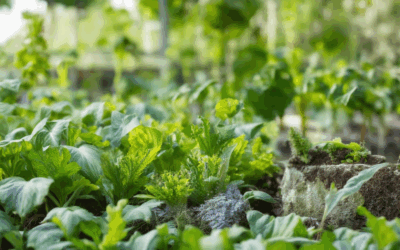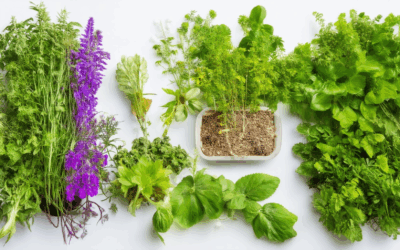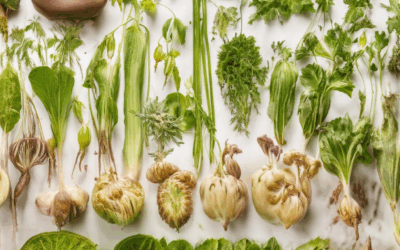Plants have been integral to life on Earth, providing essential resources, beauty, and biodiversity. Among the countless varieties, old and rare plant species hold unique genetic traits that could offer solutions to modern challenges, from climate change to food security. However, these precious plant varieties are under threat due to habitat loss, urbanization, and changing environments. In this guide, we explore practical ways to conserve old plant varieties, emphasizing the importance of saving plants and preserving biodiversity for future generations. By understanding the significance of plant diversity and employing effective conservation strategies, we can ensure that these valuable genetic resources remain protected and accessible. Whether you’re a gardener, a conservationist, or simply someone who appreciates nature’s beauty, this article offers insights and actions to help protect plant heritage and promote sustainable practices.
How to Rejuvenate Old Plants
Revitalizing older plants requires attention to their health, environment, and care routine. Here’s a step-by-step guide to help your plants thrive again:
- Check Soil Condition:** Ensure the soil is loose, well-draining, and rich in organic matter. Proper soil health is crucial for plant rejuvenation. Learn more about choosing the right soil for your plants.
- Water Appropriately:** Older plants may have root systems that are less efficient. Water deeply but avoid waterlogging. Use these watering tips to maintain optimal moisture levels.
- Prune Excess Growth:** Remove dead, diseased, or crossing branches to allow healthy growth. Discover effective pruning techniques in our pruning guide .
- Fertilize Correctly:** Apply a balanced fertilizer to boost nutrients. Use this guide to choose the right fertilizer for your plants.
- Provide Support:** Stake or support plants that may be leaning or unstable. Check out our plant support systems for secure structures.
- Divide or Transplant:** If the plant is overcrowded, divide it into smaller sections. Read our division guide for instructions.
- Encourage Biodiversity:** Attract pollinators and beneficial insects by planting companion plants. Explore our companion planting chart for ideas.
- Monitor Pests and Diseases:** Regularly inspect plants for pests or diseases. Use our pest control guide to address issues promptly.
- Give Time:** Patience is key. Notice improvements in your plant’s health over weeks rather than days. Track progress and adjust care as needed.
By following these steps, you can effectively rejuvenate old plants and restore their vitality. Remember, consistent care and attention will yield the best results. Let’s grow together and bring those plants back to life!
Why Is It Helpful To Preserve Many Different Varieties Of Plants?
Preserving diverse plant varieties offers numerous benefits that extend beyond the garden, contributing to environmental health, biodiversity, and cultural heritage.
- Biodiversity Support: Each plant species plays a unique role in the ecosystem. Diverse plants enhance resilience against climate changes, pests, and diseases, ensuring a balanced and sustainable garden environment.
- Wildlife Conservation: Plants provide essential habitats and food sources for pollinators, birds, and other wildlife. A varied plant collection ensures continuous availability of resources, supporting local ecosystems.
- Soil Health Improvement: Different plants contribute uniquely to soil health. They enhance nutrient cycling, reduce erosion, and improve soil structure, leading to better overall garden productivity.
- Cultural Significance: Heirloom and native plants hold cultural and historical value. Preserving these varieties maintains traditions and fosters a deeper connection between people and nature.
- Genetic Diversity Benefits: A broad gene pool allows for innovative breeding, resulting in more robust and adaptable plants suited for changing environments.
By embracing plant diversity, we promote ecological balance, support wildlife, enrich our soils, celebrate cultural heritage, and invest in a sustainable future. This commitment to biodiversity ensures the long-term health and productivity of our gardens and the planet.
How Can Plants Be Conserved?
To conserve plants effectively, several strategies can be employed, each contributing to the preservation of biodiversity and ecological balance. Here’s a structured approach to plant conservation:
1. Ex Situ Conservation
Ex situ conservation involves removing plants from their natural habitats to secure their survival in controlled environments. This method includes:
- Seed Banks : Storing seeds in specialized facilities, which can hold them for decades or even centuries. Seed banks offer a safe repository for genetic material, ensuring diversity is maintained.
- Tissue Culture : Preserving tissues or cells of rare or endangered species in labs, allowing for clonal propagation and the creation of new individuals.
2. In Situ Conservation
In situ conservation focuses on protecting plants in their natural habitats through:
- Habitat Restoration : Replanting native species in degraded ecosystems to restore natural habitats, ensuring biodiversity and ecological health.
- Protected Areas : Establishing reserves or parks where plants can thrive under minimal human disturbance, safeguarding their natural environments.
3. Genetic Diversity Preservation
Maintaining genetic diversity is crucial for the long-term survival of plant species. Techniques include:
- Modern Biotechnology : Utilizing tools like CRISPR for precise genetic manipulation and DNA sequencing to study and preserve unique traits of plants.
- Gene Banks : Depositing genetic material from plants, ensuring that valuable genes are not lost forever.
4. Community Involvement
Engaging communities plays a vital role in plant conservation efforts:
- Public Awareness Campaigns : Educating people about the importance of plants and their roles in ecosystems, encouraging sustainable practices.
- Local Conservation Initiatives : Partnering with local groups to implement planting programs and maintain green spaces, fostering a sense of ownership and responsibility.
5. Monitoring and Evaluation
Regular monitoring of conservation efforts ensures effectiveness and adaptability to changing conditions. This involves:
- Data Collection : Tracking the success of conservation projects through metrics like population growth or habitat improvements.
- Adaptation : Adjusting strategies based on feedback and environmental changes to ensure long-term sustainability.
By combining these approaches, we can work towards a future where plant diversity is preserved, supporting both ecosystems and human life. Explore more about plant conservation and how you can contribute to this essential cause.
How Are Rare Plants Conserved?
To conserve rare plants, a combination of scientific, legal, and community-driven efforts are employed. Here are some key methods:
- Habitat Conservation : Protecting and restoring natural habitats where rare plants thrive is a primary strategy. This includes preserving wetlands, forests, and grasslands that are critical for these species. Efforts often involve controlling invasive species and managing land to support native flora.
- Ex Situ Conservation : In addition to protecting habitats in situ, rare plants are sometimes propagated in controlled environments like botanical gardens, seed banks, and nurseries. Techniques such as seed collection, tissue culture, and micropropagation are used to ensure genetic diversity and viability for future generations.
- Legal Enforcement and Protection : Strong laws and enforcement mechanisms are essential to prevent illegal harvesting and poaching of rare plants. International and domestic agreements, along with strict penalties for violations, help safeguard these ecosystems.
- Community Involvement : Educating local communities about the importance of rare plants fosters stewardship. Programs encourage citizens to report sightings, participate in planting events, and adopt sustainable land management practices.
- Genetic Research and Reintroduction : Studying the genetics of rare plants allows for more informed conservation decisions. In some cases, plants can be reintroduced to suitable habitats after propagation and acclimatization.
- Monitoring and Evaluation : Regular monitoring of populations ensures that conservation efforts are effective. Data collected helps adjust strategies to address threats like climate change, disease, and habitat loss.
For example, the San Francisco Bay Area’s restoration projects demonstrate the success of combining habitat protection with community engagement to preserve rare plant species.
Learn more about sustainable gardening practices to support rare plant conservation efforts.
Conserving Rare Species: A Call to Action
Conserving rare species requires a multifaceted approach that combines education, action, and collaboration. Here’s how we can work toward preserving biodiversity:
- Habitat Restoration : Restore degraded ecosystems by planting native vegetation, creating wildlife corridors, and avoiding non-native invasive species. This supports local flora and fauna, providing habitats for rare species.
- Protecting Species Through Captive Breeding : In cases where wild populations are critically low, captive breeding programs can aid in reintroduction. Collaborate with wildlife conservation centers to support these efforts.
- Reducing Pollution and Disturbance : Minimize plastic waste, chemical runoff, and habitat destruction. Clean waterways and reduce industrial impacts on sensitive ecosystems.
- Combating Invasive Species : Eradicate or control invasive species that threaten native biodiversity. Regular monitoring and eradication programs can significantly protect rare species.
- Raising Awareness : Educate communities about the importance of rare species and their role in ecosystem balance. Engage locals in conservation efforts through workshops and awareness campaigns.
- Supporting Conservation Organizations : Donate to or volunteer with organizations dedicated to species conservation. Your support helps fund critical projects and research.
- Promoting Sustainable Practices : Adopt sustainable agriculture, fishing, and forestry practices. This reduces environmental strain and protects rare species indirectly.
By taking these steps, we can contribute to the survival and thriving of rare species, ensuring a healthier planet for generations to come. Let’s act now to protect our natural heritage before it’s too late.
For more resources on sustainable practices and conservation efforts, visit our sustainable agriculture page or explore our conservation programs .
How to Bring Back Extinct Plants
Bringing back extinct plants is a complex scientific challenge that involves understanding their biology, ecology, and conservation needs. While this process is not as straightforward as de-extinction efforts for animals, there are several approaches being explored to reintroduce these species to our world.
- Seed Bank Conservation: Many extinct plant species have had their seeds preserved in seed banks around the world. These banks store seeds in controlled environments to maintain viability for potential germination and resurrection efforts. Accessing and germinating these seeds is a critical step in bringing back these plants.
- Genetic Research: Modern genetic technologies, such as sequencing and CRISPR editing, allow scientists to study the DNA of extinct plants. By comparing genomes with living relatives, researchers can identify genes necessary for survival and adaptability, aiding in the creation of synthetic varieties.
- Synthetic Biology: This cutting-edge field involves designing and constructing plant genomes from scratch. By combining genetic material from multiple sources, scientists can create functional plant DNA that may have been lost in extinct species.
- In Vitro Propagation: Tissue culture and micropropagation techniques enable the growth of plant cells into complete plants in laboratory settings. This method can be used to establish populations of rare or extinct species for eventual reintroduction.
- Challenges and Considerations: Efforts to bring back extinct plants face significant hurdles, including the ethical debate over de-extinction, the high costs associated with these processes, and the uncertainty of their long-term success in wild environments.
Organizations like the Global Rewilding Alliance and Eden Reforestation Project are actively working on innovative solutions to address these challenges and advance plant resurrection.
While much progress has been made in recent years, the successful resurrection of extinct plants remains a daunting task that requires collaboration between scientists, conservationists, and policymakers. The journey toward reviving these species is not just about science—it’s also about preserving biodiversity and ensuring a healthier planet for future generations.








0 Comments